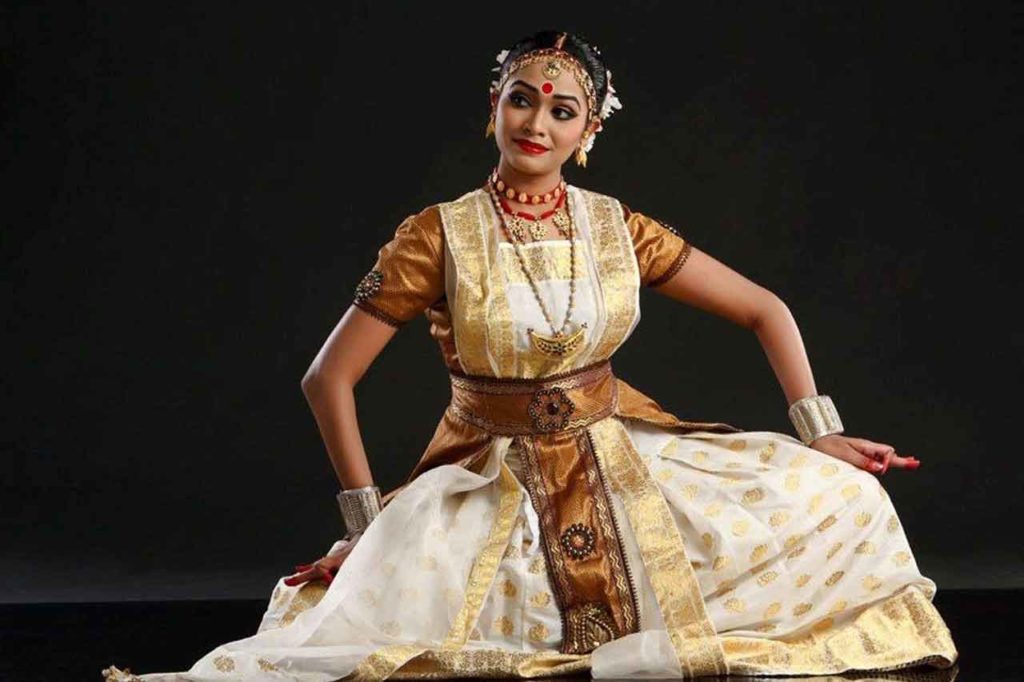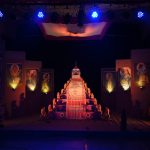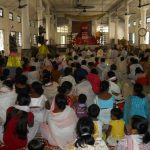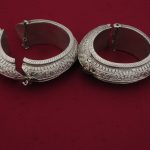Srimanta Sankaradeva (1449-1568 AD), the patron saint of the Assamese people was a social reformer besides being the founder of a new religious order Eka Sarana Nama Dharma. He used the tool of culture to preach his socio-religious ideology. One major component of these cultural elements was dance. Dance was embedded as an integral part of his literary compositions. His plays were full of dance numbers that enabled the characters to convey the sentiment of the play to the audience in lucid body language of the actors. In the process, Srimanta Sankaradeva created a new school of classical dance form. The saint to some extent followed the grammar laid down by his cultural predecessors elsewhere in Bharatavarsha, but he gave a complete shape to his classical dance form based on indigenous elements only. These elements distinguished his dance form from any other dance form in India.
The dance form of Srimanta Sankaradeva is now known as both Sankari dance and Satriya dance. The name Sankari dance is based on the argument that the first creator of this dance form was Srimanta Sankaradeva. On the other hand, the name Satriya dance is based on the argument that the dance form was preserved mostly by the Satra institution, which was founded by the saint. In Srimanta Sankaradeva’s life time, the Satra institution was however known as Than. In my view, the word Satriya covers a larger number that includes both the direct compositions of the saint as well as his followers, while the word Sankari denotes only those dances that were personally composed by the saint and his foremost disciple as well as successor Madhavadeva. So the Sankari dance is a sub-set of the Satriya dance. There are some compositions in Satriya dance, the philosophy of which runs counter to the Eka Sarana ideology of the saint. In the present article, I would consider only the early history of the dance form or the period when there was only Sankari dance. In other words, there was no difference between Sankari dance and Satriya dance in the period covered in this article. So, here we can use both the nomenclatures as identical.
We will have to go back along time to explain the background of Sankari or Satriya dance form. The Sanskrit treatise Abhinaya darpana says that an Assamese danceuse, Usha had introduced classical dance in entire India. Usha was the princess of Sonitpur, the present Tezpur and the daughter of king Bana. She lived there more than 3000 years ago and belonged to the Mahabharata era. She had no human preceptor and is described to have learnt her art from goddess Parvati. This proves that she was an original creator as it is a norm for any person to dedicate his/her best contributions to the personal deity. Usha was married to prince Aniruddha of Dwaraka. She went on to train the damsels of Sourastra in classical Lasya dance, which then spread all over India. Thus the tradition of Indian classical dance was actually derived from Assam.
The pioneering status of Assam in the history of classical dance is borne by the fact that Bharata composed Natya-shastra in between 200 BC and 200 AD, that is 1800 to 2200 years ago only. This makes it abundantly clear that the classical dance and play evolved earlier in Assam than in the rest of India. The folk dances of Assam evolved at least 6000 years ago since the folk dances develop in a region after the aborigins of that region take to farming. We have calculated the time of evolution of folk dances in Assam by taking the mid-point of Usha’s time, which was also the time of evolution of classical dance here, and the starting time of agricultural activities in North East India, which was 7000 BC. We have allowed a time lag here to permit a time space for cultural activities to pick up at leisurely pace in the ancient agrarian society of Assam. But if we consider the evolution of agriculture to be absolutely contemporary with the evolution of folk culture, then the time of development of Assamese folk dances may go back to 7000 BC, making it 9000 years old. With such a rich and old history, one does not need to borrow materials from other cultures. The genesis of Sankari or Satriya dance form lay in ancient traditions of Assam. However the family heritage of Srimanta Sankaradeva certainly helped. He belonged to a family, which had earlier maintained the tradition of Vedic songs in Kannauj.
Natya-shastra mentions Tandava dance as having been derived from sage Tandu. But the important thing is that Tandu performed his dance recital under the guidance of Shiva only.
Tatastandang samahuya proktavan surasattamah
Prayogamangaharanamachakshwa Bharataya vai.
[Meaning : Then Shiva called Tandu and said, “Please explain the uses of Angahara to Bharata.”] This implies that the Tandava dance, attributed to sage Tandu was also derived from Shiva. Since Shiva is a mythological figure, the teacher Shiva stands for the community worshipping Shiva. It is now well-established that Shiva was a tribal deity, who was Sanskritized, and that most of the tribes which worshipped Shiva belonged to Assam. Lord Bathow, the presiding deity of the Bodos is none other than lord Shiva. The Tiwas also worship Shiva and Uma in the form of old man and old woman. The ancient Kirata tribe of Assam worshipped Shiva more than 3000 years ago. All these indicate that the classical dance tradition of India originated in Assam. Sankari and Satriya dances were greatly influenced by the form and aesthetic aspect of the Tandava dance. These were dominated by male figures. This is another point of departure of Sankari and Satriya dances from other classical dance forms in India. Sankari and Satriya dances transcended sexual divisions, which no other classical dance forms of India could.
Srimanta Sankaradeva was born and brought up in such an artistic environment. Moreover he belonged to a family, which was a leading figure of the ancient Bharatiya culture. They lived in Kannauj, the nerve centre of Bharatiya culture. They migrated from there following the Muslim aggression in the Northern Bharatavarsha. Srimanta Sankaradeva’s forefathers were maestros of ancient Vedic music. So he inherited that tradition. He blended those elements with the rich ethnic heritage of Assam in order to create new dance and music.
Srimanta Sankaradeva organized his grand cultural festival Chihna-yatra barely at the age of nineteen years, in 1468 AD. The Chihna-yatra was a grand play, full of songs and dances. Srimanta Sankaradeva gave a clear idea in this drama about what he was going to do in later life. The theme of this drama dominated all his later works. We can say that Srimanta Sankaradeva had already conceptualized his own form of dance by 1468 AD. The pre-dominance of dance in the play Chihna-yatra is a proof of the overwhelming dance traditions of Assam. Srimanta Sankaradeva’s dance form, known both as Sankari dance and Satriya dance, evolved mostly from these indigenous traditions. He did not learn his art during his all-India tour, which he started in 1481 AD. It may be mentioned that the saint travelled all over India for twelve years alongwith seventeen disciples and fellow Bhuyans.
The indigenous nature of Sankari culture is evident in its ingredients. One such component is the Sutradhar or the compere of the Ankiya nat or Srimanta Sankaradeva’s plays. The Sutradhar resembles more with the Oja or the leading singer in the Oja-pali dance of Assam rather than with the Sutradhar of the Sanskrit plays. The Sankari Sutradhar remains in the arena of acting from the beginning till end. He delivers religious sermons from time to time. The Sutradhar of the Sanskrit play has no role other than introducing the play to the audience whereafter he disappears from the arena of acting. The hand and foot works of the Sankari Sutradhar have similarities with those of the Oja, but are more refined and elaborate than those.
It is mentioned in the hagiographies of Srimanta Sankaradeva that his cousin Ram Rai had once arranged a Putala-nach (toy dance) recital for entertainment of all. This proves that Srimanta Sankaradeva was acquainted with this indigenous dance form. Knowledge of this folk-dance might also have helped him in conceptualizing his own Sutradhar. The dance master of Putala-nach controls the toys with a sutra or thread. This mode of control is evident in the functioning of Sankari Sutradhar too. But it is not seen in the Sanskrit plays. Thus though the name of the compere is the same in both Sankari and Sanskrit plays, both are completely different. Another point of departure between these two plays is the inclusion of scenes pertaining to wedding, battle, killings, and eating in the Sankari plays. Srimanta Sankaradeva would have abided by the prohibitions of these scenes, had he been a keen follower of the Indian classical tradition. It is therefore evident that Sankari plays constituted a school in itself. The same thing applies to Sankari dance.
The Sankari and Satriya dances were developed for the first time in the Ankiya nat or Sankari plays. Srimanta Sankaradeva included many songs in his plays. These were recited in accompaniment of dances. The characters of the plays danced during their entry and other important moments. Thus the Sankari and Satriya dances came into being through the Ankiya plays. Even the Sutradhar participated in these dances. He is the over-all supervisor and director of the play. Srimanta Sankaradeva performed this role himself.
The songs of the Ankiya plays were rendered by a group of Gayana-Bayana. Gayana means singers and Bayana means instrumentalists or drummers of Sankari music. This system of Gayana-Bayana also was derived from indigenous traditions by Srimanta Sankaradeva. The Sonowal Kachari tribe of Assam had their own Gayana, who were known as Gandharva Gayana and who played Mridang. Srimanta Sankaradeva replaced the Mridang with his own innovation, Khol. He also incorporated new rhythms as well as hand & foot movements. The Sankari Gayana is an improved version of Gandharva Gayana.
The Sankari or Satriya dance form was not only original and beautiful, it also influenced other schools of classical dances in India. Some parts of Mati-akhora of Sankari or Satriya dance are seen in the Bharat-natyam dance too. But the former, devised by Srimanta Sankaradeva is more elaborate than the latter. There are even some elements of Hatha-yoga in them. As many as ninety types of Mati-akhora are being practised in different Than or Satra of Assam. Many of these are different from the Karan or hand and foot movement types mentioned in the Natya-shastra. Bharata had mentioned 108 types of Karan. These are seen in different classical dance forms of India in varying numbers. But Sankari or Satriya dance contains more types of hand and foot movements singularly in comparison to any other Indian classical dance form. This proves that the Sankari or Satriya dance is the oldest and the most matured among the Indian classical dances. Subhankar, the Assamese author of Srihasta Muktawali detailed different Hasta-mudras used in Assam. But unfortunately there has been an attempt now to dissociate Subhankar from the Assamese society and history by some authors outside the state.
The Sankari/Satriya dance tradition was passed on to Manipur, wherefrom it was further passed on to Bengal. Ahom king Rajeswar Singha married a Manipuri princess, Kuranga Nayani in 1768 AD. Kuranga Nayani’s father, king Bhagya Chandra was also known as Maharaj Jai Singh (1759-1798 AD). When he visited the Ahom capital, the Ahom king got a Satriya play Ravana badha enacted in the honour of Bhagya Chandra. Rajeswar Singha also presented some Gayans and Bayans to the Manipuri king. Thus Manipur came under direct influence of Assamese culture, that is Sankari culture or Satriya culture, in the late eighteenth century.
King Bhagya Chandra introduced Ras-nritya in Manipur on his return, that was in 1768 AD. He also introduced dance dramas based on Ras story in 1789 AD. These were influenced by Keli-Gopal, an Ankiya nat authored by Srimanta Sankaradeva based on the Ras story. It may be mentioned here that this play had gained extra-ordinary popularity in Northern India. The Ras-nritya by the Chaitanyaites of Bengal drew heavily on it. This influence was cemented with a strong bond, when Bhagya Chandra went to Nabadwipa in 1793 AD, after abdicating his throne in favour of his son Labanya Chandra. This had to happen as Bhagya Chandra was the man who sponsored the revival of the Vaishnavite traditions of Nabadwipa, which had been devastated by Muslim invaders. Thus Sankari and Satriya culture entered Bengal through the agency of Bhagya Chandra.
Mudras like Matsya (fish), Kurma (tortoise), etc used in the Dashavatara dance are actually the Assamese way of depicting the stories from the Bhagavata regarding the ten main incarnations of God. Gayan and Bayan present these Mudras. These were completely new innovations in Sankari dance. It deserves mention here that the book Sri hasta muktawali illustrates 71 types of Mudras against 67 types mentioned in Natya-shastra. Some of these Mudras were depicted in sculpture of Deoghar. It was the depiction of Sankari and Satriya dance form only, done at the behest of some Assamese king who ruled that area.
It may be mentioned here that Bengal was ruled by kings of Assam for as long as 2,600 years beginning from the tenth century BC upto the sixteenth century AD. And it is a universal truth that the literature and culture of any nation is invariably influenced by its rulers. The successive Hindu, Mughal and British rulers in India have showed clearly how a culture undergoes change. All of them have left their marks on Indian culture. The fact that Bengal used to be a colony of Assam for two and a half milleniums ensured that their culture developed in about the same line as that of Assam. The Bengali literature and culture were greatly influenced by the Assamese literature and culture. Four centuries of Bengal’s cultural history from sixteenth century to nineteenth century was named after the Kaliya Damana play of Srimanta Sankaradeva. The Deoghar sculptures are also evidences of expansion of Sankari and Satriya culture in Bengal.
The uniqueness of Sankari and Satriya dances is underscored by the pre-dominance of Aharya and Vasik types of acting in them. The artists convey their messages through speeches and external paraphernalia like masks, costumes etc in Sankari dances. Other classical dances of India on the other hand are characterised by Sattvic type of acting. The salient features of these dances are trembling, perspiration, fainting, shedding tears, broken voice, etc. None of these are seen in Sankari and Satriya dances. Thus Sankari and Satriya dances are distinctly different from Odissi, Kathak, Bharat-natyam etc.
The Sankari culture, which is also known as Satriya culture in an extended form, has been accepted as the main-stream culture of the state. It is the unifying bond of the numerous ethnic groups living in the Brahmaputra valley. The Assamese nation came into being mostly at the initiative of Srimanta Sankaradeva. None of the kings and emperors, who ruled in this valley before and after the saint’s lifetime could achieve that. The reason is that the concept of nation-state is not tenable in Assam, which is full of numerous ethnic groups. So no single king could ever build a nation within the confine of his ethnic domain.
Srimanta Sankaradeva created the composite Assamese culture with ingredients from all ethnic groups. Many of the hand and feet movements of his dance form were taken from the ethnic dances of Assam. Karbi, Mising, Bodo etc tribes contributed in plenty to the creation of Sankari dance form. For instance, the Hai-re, Pallav, Maira, and Lol hand-posture of the Sankari or Satriya dance was derived from the Mising dance. It may be noted that the Sankari hand postures Mujura, Pallav, Maira, Lol, Sashak, and Hai re are not found in other classical dances of India. These are purely indigenous postures used by the ethnic groups of Assam from early times. Another notable fact is that the word Hasta instead of Mudra is used in the Sankari dance to signify hand posture.
The Bodo tribe contributed some postures to the Sankari or Satriya dance from their Bagrumba. The combinations of left hand and right foot, and right hand and left foot is one such trait. Some other hand and feet postures of Bagrumba are also similar to the Sankari or Satriya dance. Srimanta Sankaradeva used the stringed instrument Sarengda of the Bodo tribe. It was appropriate for singing Bargeet. It may be mentioned that the instruments used in the rest of the country are conspicuously absent in Bargeet or other Sankari songs.
Bihu dance, a common harvest dance of the Assamese people influenced the Sutradhar dance as well as the battle dances of the Sankari or Satriya dance. The Putala-nach also contributed some characteristics to Sutradhar. The Karbi folk dance has also contributed own elements to it. The mask used by the actors in the Ankiya plays were taken from pure indigenous source. The Khamtis, the Bhutiyas and many other tribes have been using masks. The Bhor-tal was taken from the Bhutiyas. That was why it was earlier known as Bhot-tal. The Daba, a type of big drum kept in the Kirtan-ghar and the Sarai, a flat-top stand to keep the offerings to God, were also taken from indigenous ethnic sources.
Srimanta Sankaradeva had ready images and ingredients for use as materials in his performing arts, be it dance or music. The sculptures of Da-Parbatiya, Sri Surya hill, Ambari, Madana-Kamadeva devalaya, Na-Nath temple etc prove that abundantly. Sculptures of danceuses and dancing deities have been found at most of these places. The ethnic groups of the Brahmaputra valley are very rich in different performing arts. Srimanta Sankaradeva used some of these ethnic ingredients in constructing his performing art forms.
The costumes used by the artists in Sankari dances also are of indigenous origins and speciality. The headgear worn by the Sutradhar came from the Jaintia tribe. The dress of the Oja or leader in the Oja-pali dance is similar with that of Sutradhar to a great extent. The Ghuri worn by him on the lower part of the body came from the Rabha tribe. The jacket worn by him on the upper part of the body came from the Khangaliphaga of the Tiwa tribe. So the Eka Sarana Nama Dharma became a tool for social integration in the Brahmaputra valley. This process became more pronounced in the sub-cult named Kal-Sanghati. Even today the ethnic groups of Assam boast of the fusion process of Ek Sarana Nama Dharma that Sanskritized them without their giving up ethnic heritages.
Acknowledgement :
This article was earlier published in the website www.sankaradeva.com




